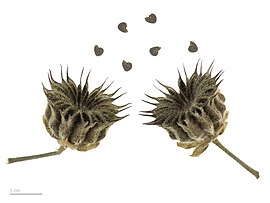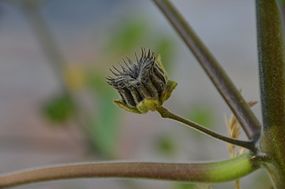Associations
provided by BioImages, the virtual fieldguide, UK
Foodplant / sap sucker
hypophyllous Coccus hesperidum sucks sap of live leaf (near veins) of Abutilon theophrasti
Remarks: season: 1-12
Foodplant / sap sucker
Pseudococcus sucks sap of live green part of Abutilon theophrasti
Foodplant / sap sucker
Rhizoecus sucks sap of live stem base of Abutilon theophrasti
Other: major host/prey
Comments
provided by eFloras
This is a very important plant for its lustrous, white bast fibres. It is extensively cultivated in China, especially in North China (Hu, l.c.). In America this is preferred over jute and Manila hemp. Aniline dyes make its natural lusture prominent (Dastur 1951). Probably in Pakistan its qualities are not known. It may be grown in northern region of our country.
- license
- cc-by-nc-sa-3.0
- copyright
- Missouri Botanical Garden, 4344 Shaw Boulevard, St. Louis, MO, 63110 USA
Comments
provided by eFloras
Abutilon theophrasti is extensively cultivated for its bast fibers, which are used to make string, rope, shoes, rugs, and countless other items; it is also used medicinally for fever, dysentery, and stomachaches. The fiber is known as "China Jute" or "Tientsin Jute."
- license
- cc-by-nc-sa-3.0
- copyright
- Missouri Botanical Garden, 4344 Shaw Boulevard, St. Louis, MO, 63110 USA
Description
provided by eFloras
Annual, 1-2 m tall velutinous herb. Leaves with 2-20 cm long petiole; stipules 5-8 mm long, caducous; blade 2-16 cm across, usually orbicular or broadly ovate, long acuminate, deeply cordate at base, minutely crenate-dentate or undulate, with 7-11 prominent nerves, velutinous-stellate hairy on both sides, more velutinous beneath. Flowers axillary, solitary or few flowered terminal raceme; pedicel 1.5-4 cm long, tomentose, articulate near the apex. Calyx c. 1 cm long, fused below the middle; lobes 4-7 mm broad, ovate or lanceolate, acuminate, stellate tomentose without, less so within. Corolla yellow; petals 1.2 cm long and broad, obovate, glabrous. Staminal column 2-4 mm long, glabrous. Ovary globose, c. 3 mm across, villous. Fruit 12-15 mm long (awns excluded), 15-20 mm broad, black.
- license
- cc-by-nc-sa-3.0
- copyright
- Missouri Botanical Garden, 4344 Shaw Boulevard, St. Louis, MO, 63110 USA
Description
provided by eFloras
Herbs subshrublike, annual, 1-2 m tall. Petiole 3-12 cm, stellate hairy; leaf blade orbicular-cordate, 5-10 cm in diam., both surfaces densely stellate pubescent, base cordate, margin minutely crenate, apex long acuminate. Flowers solitary, axillary, yellow. Pedicel 1-3 cm, pubescent, articulate near apex. Calyx cup-shaped, densely puberulent, lobes 5, ovate, ca. 6 mm. Corolla uniformly yellow; petals obovate, ca. 1 cm. Filament tube glabrous. Ovary 15-20-loculed, 1-1.5 cm, densely pubescent, apex truncate. Capsule semiglobose, ca. 1.2 × 2 cm; mericarps 15-20, stellate pilose, apex 2-awned, awns spreading, 3-5 mm, hairy. Seed reniform, brown, stellate puberulent. Fl. Jul-Aug.
- license
- cc-by-nc-sa-3.0
- copyright
- Missouri Botanical Garden, 4344 Shaw Boulevard, St. Louis, MO, 63110 USA
Distribution
provided by eFloras
Distribution: Native to India; introduced and fully naturalized in North America; North Asia and Westward to South Europe. It is of rare occurrence in Pakistan.
- license
- cc-by-nc-sa-3.0
- copyright
- Missouri Botanical Garden, 4344 Shaw Boulevard, St. Louis, MO, 63110 USA
Habitat & Distribution
provided by eFloras
Disturbed areas, neglected fields, also cultivated. Anhui, Fujian, Gansu, Guangdong, Guangxi, Hebei, Heilongjiang, Henan, Hubei, Hunan, Jiangsu, Jiangxi, Jilin, Liaoning, Nei Mongol, Ningxia, Shaanxi, Shandong, Shanghai, Sichuan, Taiwan, Xinjiang, Yunnan [India, Japan, Kazakhstan, Korea, Kyrgyzstan, Mongolia, Pakistan, Russia, Tajikistan, Thailand, Turkmenistan, Uzbekistan, Vietnam; Africa, SW Asia, Australia, Europe, North America].
- license
- cc-by-nc-sa-3.0
- copyright
- Missouri Botanical Garden, 4344 Shaw Boulevard, St. Louis, MO, 63110 USA
Synonym
provided by eFloras
Sida abutilon Linnaeus, Sp. Pl. 2: 685. 1753; Abutilon avicennae Gaertner, nom. illeg. superfl.; A. avicennae var. chinense Skvortsov; A. avicennae f. nigrum Skvortsov; A. californicum Bentham; A. pubescens Moench; A. theophrasti var. chinense (Skvortsov) S. Y. Hu; A. theophrasti var. nigrum (Skvortsov) S. Y. Hu; A. tiliifolium (Fischer) Sweet; S. tiliifolia Fischer.
- license
- cc-by-nc-sa-3.0
- copyright
- Missouri Botanical Garden, 4344 Shaw Boulevard, St. Louis, MO, 63110 USA
Abutilon theophrasti
provided by wikipedia EN
Abutilon theophrasti (velvetleaf, velvet plant, velvetweed, Chinese jute,[1] China jute, crown weed, buttonweed, lantern mallow, butterprint, pie-marker, or Indian mallow) is an annual plant in the family Malvaceae that is native to southern Asia. Its specific epithet theophrasti commemorates the ancient Greek botanist-philosopher Theophrastus.[2] Abutilon theophrasti is the type species of the genus Abutilon.
Description
Velvetleaf grows 3–8 feet tall on branched stout stems. Their stems are covered in downy hairs. It is an annual that grows during the warmer seasons, germinating in the spring and flowering in the summer. The leaves are large and heart-shaped with pointed tips at their ends, and they grow alternately at different points along the length of the stem. The leaves are attached to thick, long stems, and when crushed, they release an odor.[3]
Its flowers are yellow and grow up to an inch in diameter with five petals attached at the base. The flowers grow on stalks and can either be found in clusters or individually where the stalk meets the leaf stem.[3]
Pod-like capsules produced by the plant consists of 12-15 wood segments that form cup-like rings. Through the maturation of the seeds, the segments remain joined, and when the seed are ready to be released, the outside of the capsule contains vertical slits which release mature seeds.[3]

Abutilon theophrasti -
MHNT
Biology
Reproduction
During reproduction, the plant generates a number of seeds ranging between 700 and 44,200 units per one plant. The seeds take 17–22 days to mature once pollinated. Seeds can last for about 50 years when stored in a dry location or in the soil. In order to disperse the seeds for reproduction, each carpel in the plant is opened with a vertical slit along the outer edge. For successful germination of the seeds, the temperature must range between 24-30 °C. Due to the dry climate and high evaporation growth, Velvetleaf is unable to grow in the meadows of North America.[4] Velvet plants are able to grow in various types of soil ranged from gray-brown podzols and sandy to clay loams. The ideal soil pH for velvetleaf ranged between 6.1 and 7.8, depending on location.[5]
Cultivation and medicinal uses
Velvetleaf has been grown in China since around 2000 BCE for its strong, jute-like bast fibre.[6] The leaves are edible when stir-fried or in an omelette. The plant is known as maabulha in the Maldives and its leaves were part of the traditional Maldivian cuisine, usually finely chopped and mixed with Maldive fish and grated coconut in a dish known as mas huni.[7] The seeds are eaten in China and Kashmir.[8] The plant is also used to make ropes, coarse cloth, nets, paper and caulk for boats, and is still cultivated in China to this day.[9] Velvetleaf can be used as a treatment for dysentery and opacity of the cornea, and can treat eye injuries. The leaves of the velvet leaf contain 0.01% of rutin, and used for a soothing, lubricant treatment that softens irritated tissues. When the leaves are softened, they can be used a remedy for ulcers. The bark of Velvetleaf can reduce the flow of bodily fluids such as blood, secretions, mucous. It can promote the flow of urine.[10]
Invasive species
In midwestern and northeastern regions of the United States, eastern Canada and the Eastern Mediterranean, A. theophrasti is considered a damaging weed to agricultural crops, especially corn and soybeans.[11]
Since being introduced to North America in the 18th century, velvetleaf has become an invasive species in agricultural regions of the eastern and midwestern United States. It is one of the most detrimental weeds to corn causing decreases of up to 34% of crop yield if not controlled and costing hundreds of millions of dollars per year in control and damage. Velvetleaf is an extremely competitive plant, so much so that it can steal nutrients and water from crops.[12] Velvetleaf is controllable by herbicides even though it is known to be a major weed to different crops. Because of the season it germinates in, the plant matures right before the fall harvest in farms. Velvetleaf is a tall plant that can cause the shorter crops around it to not thrive by severely reducing light penetration to them. Not only does it affect crop plants by starving them of light, but it also houses different diseases and pests of crops like corn, cotton, soybeans, and others. When destroyed, the plant releases a chemical odor that is also known to be harmful to surrounding crops by inhibiting germination of crop seeds when that chemical is released into the soil.[3] Examples of pests and diseases that Velvetleaf harbors are maize pests, tobacco pests, and soybean diseases. In order to eradicate Velvetleaf, individual plants should be dug up or pulled out manually and not tilled or plowed to avoid seed germination. The plants can also be mowed while the it is still small.[3]
This species is typically found in areas where the soil had been disturbed. This causes the dormant seeds in the soil to be brought closer to the soil's surface, allowing for growth when the soil is at an optimally warm temperature.[13]
Threats to A. theophrasti
Different predators and pathogens affect velvetleaf at different life stages of the plant. Examples of threats include but are not limited to:[4]
References
-
^ "velvetweed" in The Columbia-Viking Desk Encyclopedia (1953), New York: Viking.
-
^ De Ruff, Robert. "A short description of Abutilon theophrasti". Plants of Upper Newport Bay.
-
^ a b c d e "Velvetleaf Identification and Control Abutilon theophrasti". KingCounty. September 18, 2018.
-
^ a b "Abutilon theophrasti (velvet leaf)". www.cabi.org. Retrieved 2019-02-11.
-
^ "Canadian Science Publishing". doi:10.4141/cjps88-127.
{{cite journal}}: Cite journal requires |journal= (help) -
^ "Velvetleaf (Abutilon theophrasti)". www.illinoiswildflowers.info.
-
^ Xavier Romero-Frias, The Maldive Islanders, A Study of the Popular Culture of an Ancient Ocean Kingdom, Barcelona 1999, ISBN 84-7254-801-5
-
^ "Velvetleaf". Written Findings of the State Noxious Weed Control Board - Class A Weed. February 2000. Archived from the original on 2006-06-16.
-
^ Steckel, Larry (July 2007). "Velvetleaf" (PDF). The University of Tennessee.
-
^ "Abutilon theophrasti China Jute, Velvetleaf, Butterprint Buttonweed Jute, China Mallow, Indian Velvet Leaf PFAF Plant Database". pfaf.org. Retrieved 2019-02-11.
-
^ Hameed A. Baloch, Antonio DiTommaso and Alan K. Watson. "Intrapopulation variation in Abutilon theophrasti seed mass and its relationship to seed germinability" (PDF). Seed Science Research (2001) 11, 335–343. Archived from the original (PDF) on 2010-06-28.
-
^ Davis, K. Renner, C. Sprague, L. Dyer, D. Mutch (2005). Integrated Weed Management. MSU
-
^ "Velvetleaf, Abutilon theophrasti". Master Gardener Program. Retrieved 2019-02-11.

- license
- cc-by-sa-3.0
- copyright
- Wikipedia authors and editors
Abutilon theophrasti: Brief Summary
provided by wikipedia EN
Abutilon theophrasti (velvetleaf, velvet plant, velvetweed, Chinese jute, China jute, crown weed, buttonweed, lantern mallow, butterprint, pie-marker, or Indian mallow) is an annual plant in the family Malvaceae that is native to southern Asia. Its specific epithet theophrasti commemorates the ancient Greek botanist-philosopher Theophrastus. Abutilon theophrasti is the type species of the genus Abutilon.
- license
- cc-by-sa-3.0
- copyright
- Wikipedia authors and editors



